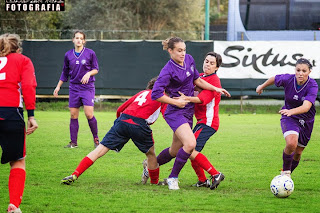Greg Downes is gallivanting around Europe. He put this report on his blog. It tells a nice story about women's soccer in Italy.While enjoying a lengthy stay in Florence I decided to put my women’s football hat on and throw my support behind the local women’s team (Associazione Calcio Femminile Firenze). As luck would have it the home ground is only a short driving distance from where we are living. The home ground is called the Stadio Comunale San Marcellino. A small stadium with a capacity of only 1,000.
Game day started wet, cold and not very inviting. I had planned the visit to the soccer but was now having reservations, as it was only 5 degrees and raining. However after a morning trip to the Greve markets (in Chianti) the weather started to clear and we headed off to the ground. The stadium – if you could call it that is situated in the outskirts of Florence, tucked away amongst the homes and businesses of suburban Italian life in the municipality of Bagno a Ripoli. While the ground itself was netted off to secure surrounding properties the pitch was good, flat, well grassed and dry even after solid rain. It promised a fast and open game.
Game time finally arrived and with that both teams, Firenze and Como 2000, along with the referee and linesmen all ran out to centre field together. Never seen that before. A moment’s silence was held for what reason I couldn't understand and then both teams shook hands and withdrew to their respective sides of the centre for kickoff.
 |
| Image from the game. Sourced from ACF Firenza site. |
While numbers were low, some things remain the same no matter where you are in the sporting world. I was standing under the grandstand waiting to be served at the bar when an elderly Italian lady approached me. She didn't recognize me from the usual crowd and wanted to introduce herself. While we both spoke poor Italian and English respectively she managed to express to me that she was a grandmother (Nonna) to one of the local players and was very proud to be here to watch her play. I could only agree in my broken Italian and said that I was very pleased to be here as well. She nodded and left to join her family. I was left with a smile on my face and a feeling of being a welcome visitor to the game.
 |
| More action from the game. |
The Serie A league for women has been around for approximately 30 years in its current format. The 2013/14 season includes a total of 16 teams representing a cross section of the country. The W-League on the other hand is a baby in comparison with its establishment in 2008! I realize crowd numbers alone is not a true indicator of a league’s success however I was amazed at the low numbers present when at home the W-League is averaging close to 1,000 plus and growing. I was also secretly hoping that as I was new to the league – one game did not make a season.
 |
| Team crests from Women's Serie A discussion board. |
We both left the ground happy to have been involved, rugged up against the cold breeze and looking forward to getting home to a warm fire.
As we were driving home my wife turned to me and said, “ That was great! Seeing that the ground is so close we should come back and support the team at all of their home games.”
Looking forward to it already. At least I can add to the attendance averages.
Check video footage of the game here.


